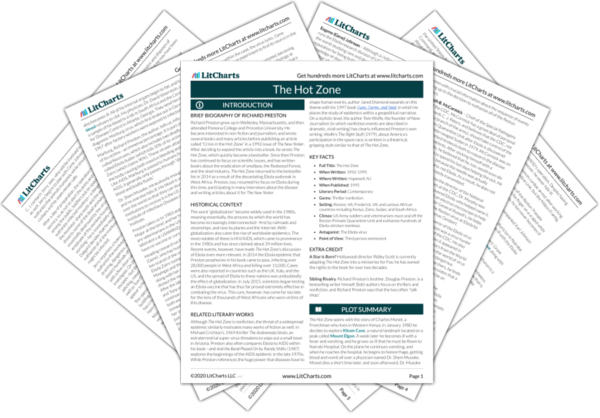Summary
Analysis
Hospital staff runs to aid Charles Monet, and they are met in the ICU by Dr. Shem Musoke, a talented and personable young physician. Musoke arrives as Monet inhales his own blood and stops breathing entirely, immediately falling into a coma. Examining Monet’s eyes, Musoke notices that his pupils are dilated, which denotes brain damage. Although he does not even have gloves on, Musoke inserts a laryngoscope down Monet’s throat, his hands becoming covered by mucus, blood, and vomit. With his face only inches from Monet, he inserts the laryngoscope, at which point Monet vomits all over the doctor, covering his face and chest (as well as the gurney and floor) with blood. Musoke, still determined to help his patient, continues to insert the scope and watches as Monet begins to breathe again. As Musoke attempts to give his patient a blood transfusion, Monet’s veins fall apart at the touch of a needle, and blood runs down his arms. All the while, he continues to hemorrhage from his bowels. Within hours, still attended by Dr. Musoke, he dies.
Within this narrative, Dr. Shem Musoke is a figure of great courage and selflessness, immediately helping Monet and remaining unfazed despite the infected man’s horrific symptoms. Yet Musoke will soon also become a victim of the virus himself. He is brave and devoted to his duty as a doctor, but also incredibly vulnerable to the unknown disease. Musoke is the first of many doctors, researchers, and scientists within the book who put their lives at risk in order to combat Ebola. Blood, meanwhile, continues to be a major presence within the scene, a reminder of the persistence with which Ebola attempts to infect other hosts.
Themes
The doctors of Nairobi Hospital autopsy Monet, and find that his kidneys and liver have essentially liquefied, as has his intestinal lining. It is impossible to say why he died because so many things have gone wrong: his blood has clotted, he has hemorrhaged, his liver has dissolved, and his intestines have come apart. His remains are placed in a waterproof bag and buried in an unmarked grave.
Ebola, this passage makes clear, is a kind of ultimate weapon against the human body, affecting the blood, the brain, and multiple other organs. This explains why Ebola is so terrifying, and so difficult to survive.
Themes
Nine days later, on January 24, 1980, Dr. Shem Musoke develops a severe backache, which he chalks up to exhaustion. When he looks in the mirror, however, he sees that his eyes have turned red. Noticing that he has a fever and that his backache has spread, he decides that he has malaria, and begins to take antimalarial pills and an injection. The shot, however, causes him terrible pain, and after he develops abdominal pain, he begins to wonder whether he may have typhoid fever. Although he takes antibiotics and continues working at the hospital, Musoke’s pain only grows, and he becomes jaundiced. He consults his colleague, Dr. Antonia Bagshawe, who speculates that he may have a gall-bladder attack or a liver infection. Very ill, he is placed in a private room, and his face becomes slack and dead-looking.
The virus has now moved onto another host, and Dr. Shem Musoke transitions from hero to victim. As with Monet, Preston intimately and intricately describes Musoke’s symptoms. This sense of repetition makes the menace of Ebola seem all the more inevitable and unstoppable. At the same time, Preston emphasizes the horror of a potential epidemic while downplaying the fact that of all the people exposed to Monet—even those on his plane and in the bloody waiting room—only Musoke, who was covered in Monet’s blood and totally unprotected, catches his disease.
Themes
In an attempt to determine what is wrong with Musoke, a team of surgeons led by Dr. Imre Lofler performs exploratory surgery. They find that his liver is swollen and red. His blood refuses to coagulate, so he keeps bleeding during the surgery and blood is everywhere. After taking a sample of his liver, the team gives up.
As it did to Monet, Ebola has now begun to shut down Musoke’s body. His blood, meanwhile, is incredibly dangerous, and puts all the medical personnel who interact with it at risk.
Themes
Get the entire The Hot Zone LitChart as a printable PDF.

After the surgery, Musoke’s kidneys begin to fail, and he seems close to death. Since Dr. Antonia Bagshawe is away, Dr. David Silverstein steps in to care for Musoke. With his colleagues deeply disturbed about Musoke’s illness, Silverstein begins to test his fellow doctor’s blood for viruses, distilling the liquid down to a gold-colored serum that he then freezes and sends to both a lab in South Africa and the Centers for Disease Control in Atlanta, Georgia.
The scope of the narrative now widens as Musoke’s blood is sent out to different countries for testing. Globalization is a crucial force in the story of Ebola, allowing the international spread of the disease, but also helping far-off doctors and scientists to research and combat the virus.
Themes












